JTL Base Comparison
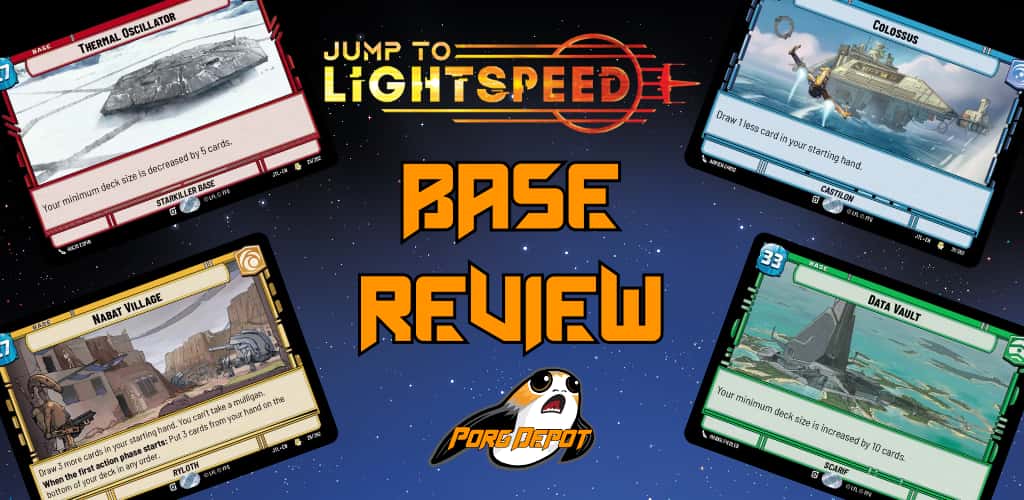
The new set of Jump to Lightspeed bases are an interesting cycle that play on the same theme. Number of cards and base hit points have a relationship. These bases try to answer the question, “What is it worth to have more/fewer cards available?”
Colossus
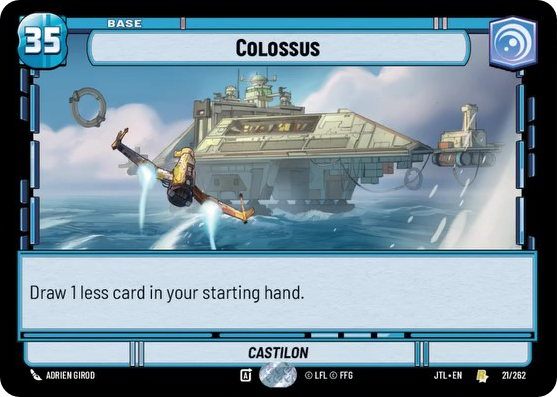
Straight from the oceans of Castilon, the Colossus can fuel you up with more hit points to start out your games.
Vigilance has always been the control oriented aspect. The Bossk Blue decks of the season zero meta have shown just how powerful removal and healing can be. Colossus brings the advantage of starting with the highest hit points on a base to date with the downside of beginning the game with one less card in your opening hand.
However, starting with only five cards could be quite a problem. Considering that a normal hand is not really a six card hand but rather four since two of those cards become the first resources played. With five cards to start out with, going down to only three after resourcing becomes potentially very tricky. This is of course very simple arithmetic but it is worth pointing out. Diving a little deeper into the math, the chances to draw a single specific card that has three copies in a deck drops from 54.34% with a 6 card starting hand down to 47.59% with a five card starting hand. This is assuming a deck size of fifty cards and includes the mulligan.
The math above really is just helping to illustrate a simple point that while there is an advantage to a control deck having additional hit points on its base, this advantage is mitigated by reducing the cards initially available to that deck which in turn will make it a bit more tricky for the control player to get to a stabilized game state and take over in the later parts of the game.
There are some good ways that a savvy deck builder can try to overcome that ~7% disadvantage in drawing a specific card in your opening hand. The most obvious way is to include some extra cards that allow you to draw, in order to make up for the missing card. In the above-mentioned Bossk Blue deck, Dr Pershing could make up for the missing card, although you are ~7% less likely to have him on turn one. Another thought is to play multiple cards that have a similar effect, essentially doubling that effective card count. Power of the Dark Side and Merciless Content are a great example of this. They have a very similar effect and both cost the same number of resources to play. You could include three copies of each to give you 6 target cards, bringing your draw percentage up to 73.73% from 47.59%. Cards like this can bring out the best deck-builder in all of us.
Data Vault
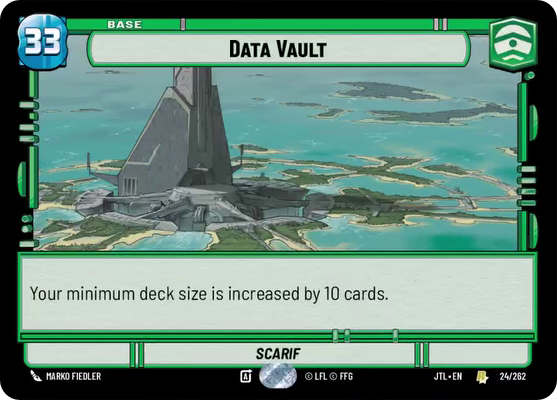
The Data Vault of Scarif holds a ton of the Empire’s most secretive and valuable data archives. Now your deck will hold more as well.
Data Vault is very similar to Colossus in that it also has increased hit points and a disadvantage to compensate. In this case the starting hand size remains the same and the deck size is the thing that increases.
There is a similar impact on card drawing odds here. Again a 50 card deck has 54.34% chance to draw one specific card that has three copies including the mulligan. Going up to a 60 card deck decreases those chances to 47.46% chance to draw the card including the mulligan.
With a 50 card deck, two 2 cost cards both being in the opening hand would be 9.28% chance to have both. With a 60 card deck that drops to 6.62%. That is a fairly significant decrease, if you are playing a deck that relies on multiple card synergies.
The ways to overcome the Data Vault disadvantages are similar to how we approached the Colossus. If you can find cards with similar effects and costs that can effectively double the count of a specific card, as with Power of the Dark Side and Merciless Contest, your chance of drawing one of them goes from 47.46% all the way up to 73.39%! We know this isn’t always easy to find a comparable card, and some concessions may have to be made. Are those concessions worth 3 life? Maybe.
This may be the weakest of the new rare base set and the impact to the card drawing odds may not be worth the additional three hit points.
Thermal Oscillator
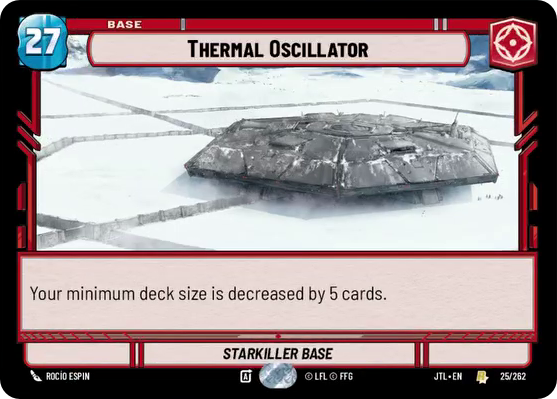
The Thermal Oscillator on Starkiller Base helped keep the planet from destabilizing. Using this base you can keep your deck stable during a tournament deck check even with the reduced number of cards in it.
Very similar to the Data Vault, but this time moving in the other direction. In this case decreasing the minimum deck size by five cards down to 45.
The drop in deck size has a positive impact on trying to draw something specific. Removing those five cards increases the chances to draw a single specific card with three copies from the standard 54.34% up to 58.52%. Again these numbers include the mulligan draw as well.
Things start to get a bit interesting when we think about a two card combo. Let’s consider a 4 cost card and a 5 cost card both with three copies in the deck. The chances to draw both of those cards and play them on the first round you could play them would be 31.29% in a fifty card deck. This does not factor in any resource ramp, additional card drawing beyond the normal two per round, and assumes that one resource is played each turn. Dropping the deck size by only those five cards raises the chances of getting that two card combo on curve to 36.70%. Approximately 5% may not seem like a huge gain, but over the course of a tournament, that could lead to drawing that combo one extra time.
Deck construction could get tricky as with the two card combo you would already be down to 39 available slots left in the 45 card deck. Plus even going back up to 46 total cards starts to negate the actual advantage that the Thermal Oscillator gives you.
Nabat Village
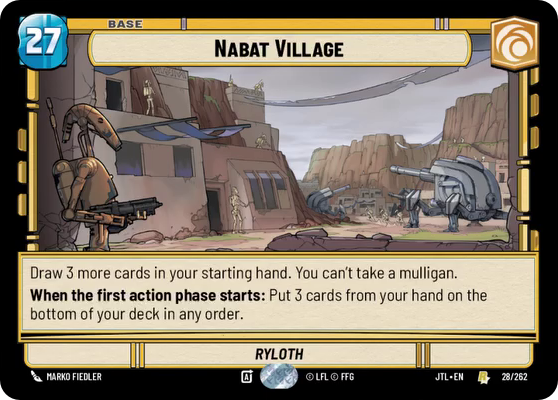
The inhabitants of Ryloth also seem to like card combos. Must be the dual headtails that gets them thinking that way. Now you can harness the Nabat Village’s increased opening draw to help get to combos too.
Not factoring in a mulligan chance, drawing additional cards up front obviously increases the odds of seeing specific cards. Drawing those extra three increases the odds of seeing a specific three copy card in the opening draw from 32.43% up to 45.61%. Then it gets trickier as a generic 30 hit point base would get a six card mulligan increasing the chances to see that card from 32.43% up to 54.34%. The Nabat Village chances are pretty solidly just within that range.
Mulligans are an interesting thing. In theory you could ditch your opening hand, reshuffle and then see the exact same six cards that you saw the first time. Nabat Village has the advantage of digging farther into the deck on any specific individual shuffle. Let’s say you are looking for a 5 cost card to play with your five resources in round four. With a generic common base you will have seen 12 total cards at that point, 6 from the starting hand plus 2 each round during the regroup phases of the first three rounds for another 6 cards. Nabat Village gets to see 9 cards initially and then draws the same number over those first few rounds getting to see 15 total cards by round four. Across those rounds Nabat Village sees 30% of the deck and the generic base sees 24% of the deck.
The math behind Nabat Village starts to come forward when looking at some other factors. First, you get to resource your first 2 cards before you have to put 3 on the bottom. Having 9 cards to choose your first resources from can be excellent. You have a better chance of grabbing that Smuggle card without taking as many card options from your hand. Combos also become very interesting with Nabat Village. If you are looking for 2 or more specific cards, you are more likely to see them in 9 than you are to see both in a single set of 6, even with a mulligan. One example that comes to mind is Now There are Two of Them. Having the ability to choose the combo pieces you want in the top 9 can be more powerful than hoping to draw them in 6.
Which then is better, the mulligan or the additional digging into the deck? Hard to say at this point and not sure the math suggests a clear winner either way. It will probably come down to the type of deck you are playing, and what your game plan is in those early turns. Given that Nabat Village starts at 27 hit points instead of the generic base’s 30, it’s clear that the game designers believe the additional digging is more beneficial than the mulligan. As the Jump to Lightspeed meta takes shape we’ll see if this pans out in actual game play.
Conclusions
The Jump to Lightspeed rare base cycle is very intriguing. The FFG design team did a pretty good job in combining advantages and mitigating with suitable disadvantages such that none of the bases seem overpowered. Even with those downsides, they are likely the first set of rare bases where arguably all of them could see top level play in Premier events. The idea of your cards affecting the game status before you even start playing is an incredibly interesting design space that I love seeing FFG explore.
Which of these new rare bases is the most powerful or most likely to see heavy play is yet to be determined. Even when looking strictly at which one is better for a combo deck it may simply come down to which one fits the aspects of the cards involved in the combo and not which base has the better math behind it.
One thing’s for sure. It will be VERY interesting to see what people can brew up with these new bases.